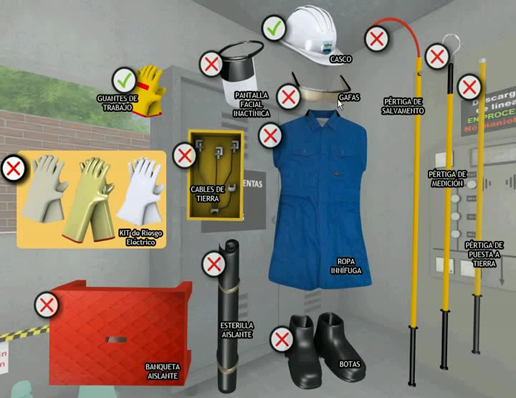Work on Electrical Installations and in premises presenting a fire or explosion hazard
Definitions and concepts:
20. Technical instructions
20.1 Disconnecting and reconnecting the power supply in an installation
Work on HV overhead lines and conductors
In work on bare HV overhead lines and conductors, the short-circuits to ground must be placed on both side of the work area and on each of the conductors that enter the area; at least one of the short-circuit to ground devices or equipment must be visible from the work area. Exceptions:
- If there is no cut-off of conductors during the work, a single short-circuit to ground device may be installed in the work area.
- When the short-circuit to ground devices and equipment cannot be seen from the work area, a local grounding device, an additional signalling device or any other equivalent identification must also be installed.
When work is carried out on a single conductor on a high voltage overhead line, the short-circuit is not required in the work area, provided that:
- All the conductors at the disconnection points are short-circuited to ground in accordance with the aforementioned instructions.
- The conductor on which work is to be carried out and all the conducting elements –except the other phases– inside the work area are electrically joined to one another and grounded by a suitable device or appropriate equipment.
- The earth conductor, the work area and the worker are outside the danger zone determined by the other conductors of the same electrical installation.
In work on insulated HV overhead power lines, the short-circuit to ground is to be placed on the bare elements of the opening points of the installation or as close as possible to these points, on each side of the work area.
Work on installations with condensers that allow the dangerous accumulation of energy
To leave these installations free of voltage, do as follows:
- Carry out and ensure the separation of possible voltage sources by means of disconnection (visible cut-off or reliable absence-of-voltage tell-tales).
- Apply a discharge circuit to the condenser terminals and wait the necessary time for discharge to take place.
- Short-circuit the condensers to ground.
Work on HV transformers and machinery
- To work in the absence of voltage on a power or voltage transformer, all the circuits of the primary winding and all the circuits of the secondary winding are to be left voltage free. If the characteristics of the means of cut-off so allow it, separation of the lower voltage circuits is to be carried out first. Proceed in the inverse order to re-establish the voltage supply.
- To work in the absence of voltage on a current transformer or on the circuits that supply it, the primary winding is to be previously left free of voltage, i.e. dead. Opening the circuits connected to the secondary winding is forbidden when the primary winding is live, except when necessary for some reason, in which case the secondary winding terminals should be short-circuited.
- Before manipulating the inside of an electric motor or generator, the following points must be checked:
- 1. That the machine has stopped completely.
- 2. That the power supplies are disconnected.
- 3. That the terminals are short-circuited to ground.
- 4. That the fire protection system is blocked.
- 5. That the atmosphere is not noxious, toxic or inflammable.
Personal Protective Equipment
Depending on the work to carry out:
- In LV installations, where a complete enclosure exists: Basic PPE (safety helmet, footwear and goggles), as well as the Company’s work clothes.
- In LV installations, without an enclosure: basic PPE and a LVW kit, as well as fireproof clothing.
- In HV installations, in local manoeuvres: basic PPE, as well as a visor with protection against electric arcs (infrared and ultraviolet radiation, burns and projections), fireproof gloves and, over these, insulating gloves suitable for the voltage and fireproof clothing.
- In HV installations, in remote manoeuvres: Basic PPE (safety helmet, footwear and goggles), as well as the Company’s work clothes.





